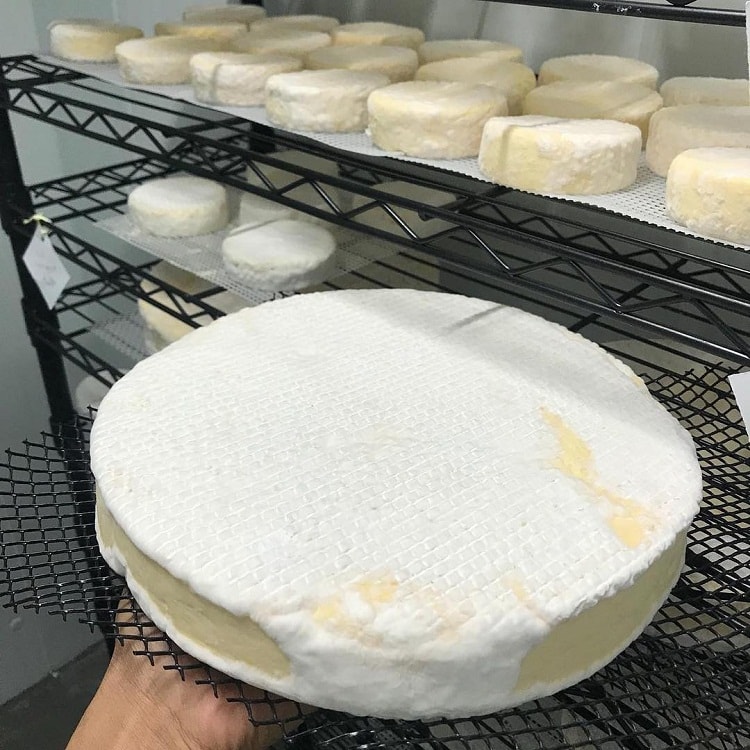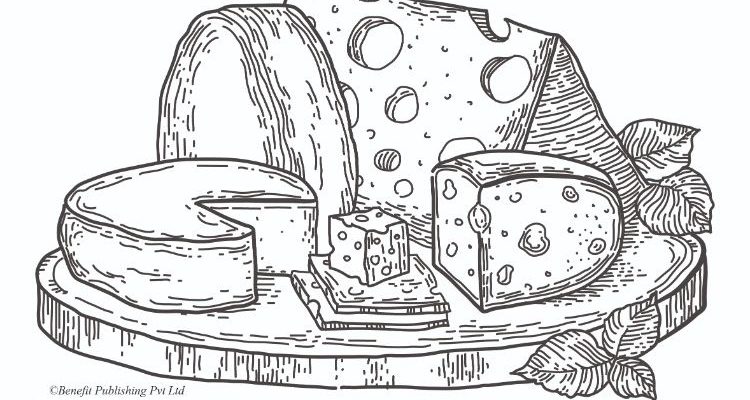A new artisanal cheese brand born in south India flies the ‘Made in India’ flag high by making gourmet cheeses of Italy, France and Denmark, which are otherwise imported.
◊ By Bhumika K; photos courtesy of Begum Victoria
Visit ORGANIC SHOP by Pure & Eco India
That Bengaluru has some of the best weather in India is now a given. We may not have the rolling hills of Switzerland here, but get ready, though, for some famous alpine cheese varieties emerging from this green city. There’s a new urban artisanal cheese brand emerging from a cheese cave tucked away in a cosy plot in the city’s Victoria Layout. And Bengaluru will boast its own Brie, Bel Paese, Cheddar and Fontina.

No, not a cake, but a giant Brie, maturing slowly in Begum Victoria’s brie cave
BY CHEESE LOVERS, FOR CHEESE LOVERS
Begum Victoria took shape quite “accidentally” over a social interaction at a dinner party. A cheesemaking venture was soon on the minds of Shruti Golchha, Pooja Reddy and chef Manu Chandra. While Manu Chandra is one of the most sought-after culinary wizards of the city, with restaurants like Toast & Tonic, Olive Beach, and Monkey Bar under his apron, Pooja Reddy was an investment banker in New York. Shruti was a fashion designer focused on the international women’s sleepwear market.
“The three of us came together because of our love for cheese. Fed up of importing it, we decided to create an infrastructure to make and service other cheese lovers like us,” says Golchha. Imported cheeses tend to be expensive and taste “plastic-y” and “preserved”; the import journey cannot ensure freshness.

Slabs of Begum Victoria’s Bel Paese
Creating a great-tasting made-in-India artisanal cheese brand that can bring out some of the best Italian, French and Danish cheese varieties became their focus. Indian-born dairy and cheese specialist from Canada, Aditya Raghavan, came on board as consultant and helped Begum Victoria develop its aged, ripened cheeses. “We wanted flavours that were full and delicious but not challenging; something accessible to India’s palate,” says Golchha.
“We wanted a name that would tell its own story and serve as our introduction. The name is partly derived from our cheesemaking facility being on Victoria Layout, indicative of our emotional connect with the place. We wanted a name which would be quirky, fun and resonate with people, hoping the name itself would stand out and serve as a self-advertising tool. Begum adds the quirk, the unexpectedness of this wonderful-tasting modern product made with local ingredients,” says Reddy.
“What sets Begum Victoria apart is the story itself – of three non-cheese-makers getting into the venture,” says Chandra. “It also ties into my philosophy of owning the supply chain at some level because it gives you the ability to showcase unique products in your own restaurant,” he adds. Currently, Begum Victoria’s cheeses are available as a cheese platter at his Toast & Tonic.
Begum Victoria’s cheesemaking journey began a year ago, and the first 6 months were spent finding the right place to make the cheese, as per the FSSAI (Food Safety and Standards Authority of India) guidelines in setting up the facility, be it the kitchen or the cave. Raghavan helped set up and start off the cheesemaking process with recipes, knowhow on cave management, training of staff, etc. Finding the right milk quality took a long time. Begum avoids the use of animal-based products like rennet, rendering its cheeses 100% vegetarian.
After setting up of the facility came many months of trial and error, to perfect the taste and quality. The team went through numerous batches of cheeses, following exacting and precision-driven processes. All this, without knowing how the cheese would actually turn out, as most cheeses need to age over several months.
METICULOUS PRODUCTION PROCESS
Begum Victoria currently produces 500 to 600 kg of cheese a month. Its cheese is delicately handmade in small batches with emphasis on quality of ingredients. “We shun the usage of chemical stabilisers or preservatives,” stresses Golchha. “Also, we are using only responsibly sourced A2 cow’s milk (which comes in fresh every day from Hosur in Tamil Nadu) from a reliable resource. Practices we are using are very stringent; we are not here for a quick buck and this allows us the ability to be patient and create products that will hopefully be able to stand against contemporaries. The endeavour is to create outstanding products and that takes time,” says Chandra.
In the above video, Manu Chandra demonstrates how to check for a clean break after the milk has been coagulated using (vegetarian) rennet. The cheese featured is an annatto-coloured cheddar. A clean break indicates that the rennet has worked effectively and that it is safe to proceed towards the cutting of the curds. Source: @begumvictoriacheese
The production cycle takes up to two days, following which, the maturing/ageing process can take from two months to a year. “Depending upon the type, you age a cheese anywhere from a few weeks to up to a year (and sometimes longer). Bel Paese is ready after only two months of ageing, but a Parmesan-style cheese needs to age for 9 to 12 months. Camemberts and Bries are perfect after 6 weeks. As the cheese ages, the bacteria stays active and creates a lot of flavour. The acidity and flavour increases. Younger cheeses are nuttier; they sharpen with age. Drying also plays a part in concentrating flavour. The acidity and drying alter the protein structure of the cheese and that is what gives Fontina its characteristic crumbly texture,” explains Reddy.
What we do tend to use in India in our regular home-cooking is processed cheese, which does not undergo the elaborate flavour-enhancing ageing process.
CHEESE CAVE MIMICS ALPINE CONDITIONS
Cheeses are traditionally aged in natural caves in Alpine regions. But in their absence, you now have a modern avatar. The cheese cave of Begum Victoria, though conjuring a very rustic image, is actually a steely freezing vault on their site where natural Alpine cave temperatures are mimicked at 9 to 14 °C; it’s an exciting space where you come upon stacks of wheels of cheeses of many shapes, sizes and colours. The cheese wheels are constantly monitored, turned, and brushed down. A cave is critical to cheesemaking because temperature and humidity determine how the protein structure in cheese evolves.

The cheese cave at Begum Victoria, where cheeses come of age
The different factors that differentiate various types of cheeses, in terms of taste and texture, are the culture, heating and cutting process (in softer cheeses the curd size is larger, whereas in harder cheeses the curd size is smaller), pressing of weights, ageing duration, and maintenance and upkeep in the cave, shares Reddy. Cave management is the most arduous part of cheesemaking and not very forgiving to even minute and seemingly imperceptible variations in process.
Begum’s cheese is also distinctive in that they grow a natural rind rather than the usual waxed rinds, which help preserve cheese longer.
The fromagerie also makes cheeses infused with dill, rosemary, thyme and edible flowers (grown on Begum Victoria’s mini farm on the premises), and also offers a limited edition cheese infused with truffles and truffle oil.
As the cheese ages, the bacteria stays active and creates a lot of flavour. The acidity and flavour increase with the passage of time. Younger cheeses are nuttier; they sharpen with age. What we tend to use in India in our regular home-cooking is processed cheese, which does not undergo the elaborate flavour-enhancing ageing process
DEMAND FOR HOMEGROWN ARTISANAL CHEESE GROWING
The demand for artisanal cheese is driven on one hand by millennials, who are moving away from mass produced to handcrafted, observes Reddy, and on the other hand by the farm-to-fork boom. “Most popular gourmet supermarkets stock imported commercial foreign cheeses alongside wheels from fresh artisanal fromageries. And south India is the site for this revolution. With high disposable income, people are eager to experiment with different kinds of cheeses locally,” she adds.
Mirroring the media consumption habits of its primary target group—millennials—Begum Victoria has ignored traditional promotional channels such as a website in favour of social media to grow sales organically.
As of now, its cheeses, priced between Rs 240 and Rs 370 per 200 gm, are only available in Bengaluru. Next, the trio plans to start a café to serve Begum Victoria’s cheeses and eventually will make them available to cheese lovers nationwide.
HOW CHEESE IS MADE AT BEGUM VICTORIA
– By Pooja Reddy, Co Founder, Begum Victoria
Our cheesemaking process begins in the morning at around 7.30 am, after receiving responsibly sourced A2 milk from a dairy farm.
Milk is first pasteurised, cooled and then cultures (good bacteria) are added to kickstart the cheesemaking process. The cultures help determine the ultimate flavour and texture of the cheese. Next, a milk-clotting enzyme called rennet, (we use a vegetarian microbial rennet) is added to coagulate the milk, forming a custard/curd-like mass.
After letting the requisite time for setting pass, the cutting starts, in which the curd is cut into small pieces to begin the process of separating the liquid (whey) from the milk solids (curds). We continue to cook and stir the curds and whey until the desired temperature and firmness of the curd is achieved. The whey is then drained off, leaving behind a tightly formed curd mass.
The curd mass is then pressed into moulds and left at room temperature for 12 to 14 hours. It is then salted—either added to the curds at the time of moulding—or immersed in brine for several hours.
Finally, the cheese is sent to the temperature-controlled cave for ageing.

A cheese platter featuring Begum Victoria’s Fontina, Havarti, Bel Paese and Brie is on offer at chef Manu Chandra’s Toast & Tonic



Can you send vacuum packed mature cheddar to Calicut, Kerala?
is it possible to have small training on cheeses making at your plant
Hi Mr Ghosh. We recommend you contact the team directly. Here are their contact details:
Address: #20, 2nd Cross, Victoria Rd, Bangalore, Karnataka
Email: [email protected]
Ph: +91- 98863 77853
Website: http://www.facebook.com/pg/begumvictoriacheese
Hi. Do you have a store we can visit to see your offering? I live in Bangalore